Copyright 2020 - 2021 irantour.tours all right reserved
Designed by Behsazanhost
Kataleh Khour Cave
Kataleh Khour Cave
Kotaleh Khour Cave, located 165 km southwest of Zanjan, is one of the most beautiful caves in the world. The stalagmites in Kotaleh Khour Cave have turned into beautiful shapes by the lapse of time including statue shapes resembling bride and groom, the wedding table, bride-groom alley, candle castle, holy Mary Hall, and the withered palm tree giving a special glamour to the cave, bewildering visitors. The skeleton of a quadruped animal, which has turned into calcite belonging to the fourth geological era, is seen in one of the chambers of the cave. Traces of life can be seen in the dark atmosphere of the cave as far as 700 meters from the cave entrance, which has historical value. A complex holding 12 residential suites, a large hall, lobby, coffee shop, welfare facilities, as well as handicrafts, and cultural and foodstuff pavilions has been set up near the cave for tourists.
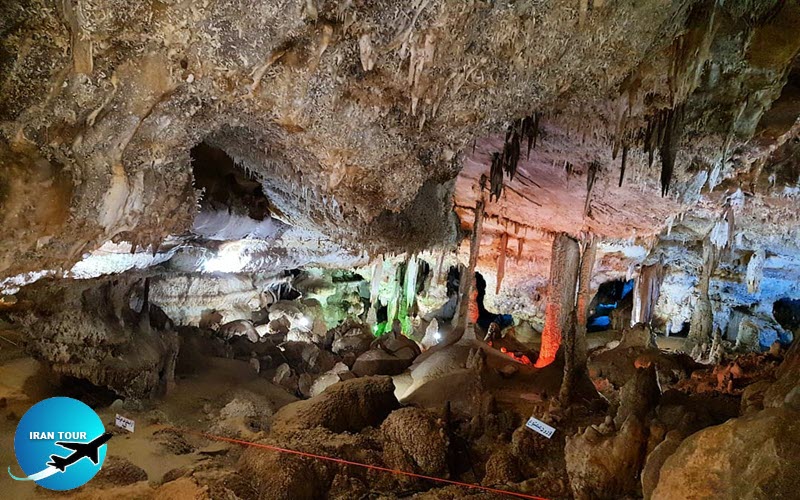 |
Iran, with its bright and life-giving sunlight, broad and green plains, thick forests, relentless deserts, tall and picturesque mountains, wild rivers, and spectacular caves, has a beautiful and unique nature. Its splendid nature has numerous secrets and myths that lead man to think about the Almighty God. One of these secrets is the beauty seen in the nature of the vast and spectacular Kotaleh Khour Cave in Zanjan, whose glamour and beauty makes any visitor dazzled. Prehistoric people used caves as shelters and secure dwellings while the civilized man of today uses this natural phenomenon in other ways.
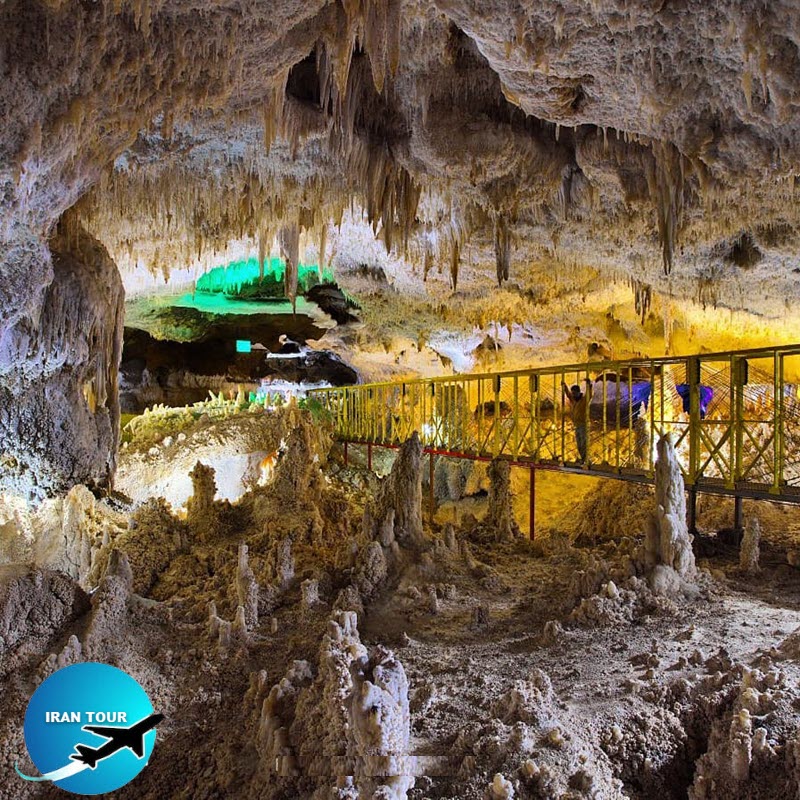 |
Today, caves are used for industrial purposes in connection with energy and water resources and reserves and for expanding irrigation networks. Because of having desirable climate, some of them are used in many countries to cultivate and reproduce special herbs. These caves can also be used as safe havens at the time of natural or human disasters. In many countries caves have turned into favorable places attracting tourists. The Kotaleh Khour Cave is one of the most beautiful caves in the world. It is located 165 km southwest of Zanjan. It can be reached through Zanjan-SoltaniyehKhodabandeh road and also through the main road of Bijar-Hamedan Kabootar Ahang. The mouth of the cave has developed inside the southern slope of the 2,000-meter Saqizlou Mountain. It is connected to the city of Garmab via a 5-km asphalted road. Saqizlou is the only mountain near the city of Garmab.
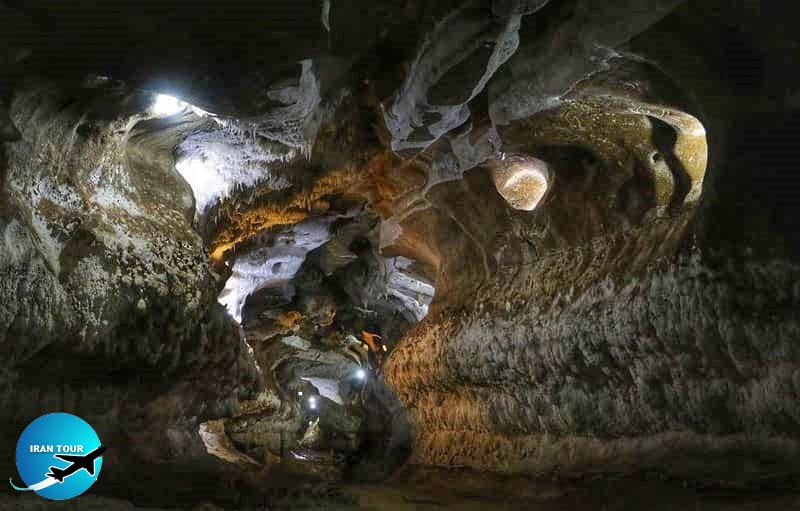 |
The mouth of the cave was at first a small hole with a triangle-shaped arch. Later and in different stages, it was carved to have a height of 1.5 meters. The cave runs through the rock, opening out into a huge chamber located about 400 meters from the cave entrance. This chamber is very wide and has a high roof, even walls, and an uneven floor. Its high roof speaks of an age-old history. From this chamber onward a gallery of passages, as well as small and big paths, gradually take shape. From inside the chambers, each of which holds between 200 to 300 sq. meters of area, narrow galleries are found in different directions. Some of these galleries are dead-end and some have very narrow access to other chambers and channels. Many of these narrow passages and routes have not been explored and still remain unknown. The floors of these chambers and passages are mostly uneven. This unevenness has been caused as a result of the erosion of rocks and the formation of irregular waterways and small wells, which dissolve the limestone rocks. Deep and scattered waterways and rivers wind through some of the chambers and passages. Visitors can see beautiful downward crystallized pillars hanging from the roof in many of these chambers.
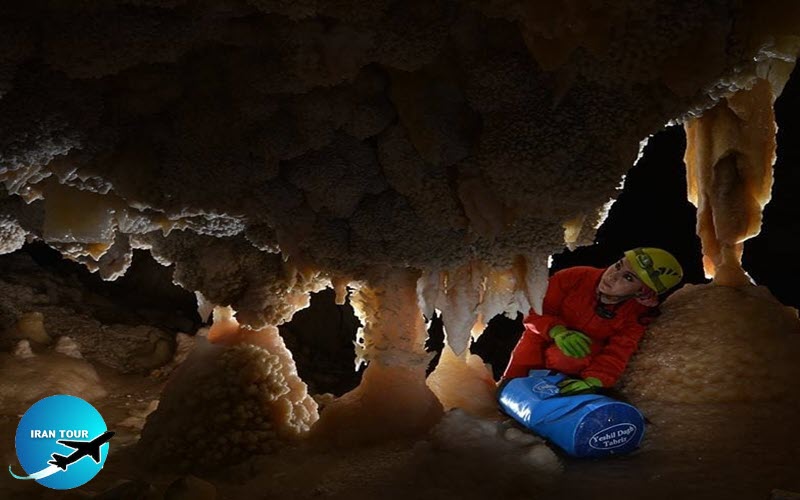 |
The original entrance channels were very narrow in their natural forms but comfortable passes have been made in them later in different operations. The entrance chamber reaches a large arched area within a distance of 300 to 400 meters from the mouth of the cave. There are numerous holes in the floor of this area and its roof is very high. There are several passages connecting the area to various routes, some dead-ends and some very narrow. Most of these routes are slanting towards the arched area. The appearance of the cave shows that karst formation in limestone and erosion of rocks has created this phenomenon over a long period of time and that a running waterway had existed there. With respect to the topography of this limestone phenomenon from the outside and its environmental characteristics, it can be said that the entrance chambers and the passages. connected to them constitute one of the layers of the cave system and for sure there are other layers in the lower or even upper parts of the cave. Usually, large cave systems lie in regions made of limestone rock. For thousands of years, rainwater, which is naturally acidic, dissolved away the limestone. Small cracks formed, slowly widening to create deep holes which became caves and rivers as water continued to erode the rock.
 |
Drops of water seeping down from above dissolve a white mineral called calcite from the rock. As the water dries, small amounts of calcite are left behind. In a very slow process taking thousands of years, these build up to form stalactites. Meanwhile, water dripping from the roof or from a stalactite falls to the cave floor, leaving layers of calcite on the floor. In this way, a pillar called a stalagmite slowly builds upwards. The stalagmites in Kotaleh Khour Cave have turned into beautiful shapes by the lapse of time including statue shapes resembling bride and groom, the wedding table, the bride-groom alley, the candle castle, the holy Mary Hall, and the withered palm tree giving a special glamour to the cave, bewildering visitors. The most striking phenomena can be seen around the springs and marshlands. Stalactites and stalagmites are located at a height of 30 to 40 meters from the roof or floor of the cave. This along with the murmuring voice of water drops creates a wonderful and memorable scene. Traces of life can be seen in the dark atmosphere of the cave as far as 700 meters from the cave entrance in the form of various kinds of earthenware pieces and skeletons. The items collected in this cave are mainly broken earthenware pieces. The most ancient ones are smoked, hand-made dark-colored earthenware dating back to the end of the second millennium B.C. The second category of the items comprises handmade earthenware pieces, which have covers.
 |
They are brownish-red and relatively rough. These are comparable to the earthenware pieces belonging to the first to third centuries A.C. The third category consists of the collected pieces of the new era, mainly jars, and plates. At this juncture, they do not have any historical value. At the end of one of the passages, there is a large chamber where one can see the skeleton of a quadruped animal, which has turned into calcite. With tall feet and hooves on one hand and a long tail and a relatively big head does not resemble ordinary animals. It seems to be one of the prehistoric animals with a special shape, which should be studied from a natural point of view among animals belonging to the fourth geological era. Kotaleh Khour Cave Local people have expressed different viewpoints regarding the cave, making up strange stories. For instance, they have said that under the Kotaleh Khour mountain there is another mountain that is made up of white flour. They also said that on one side of the cave, there is a lake with glassy and sweet potable water, which is so big, that one cannot see its shores wherever he/she stands. Still, some others believed that there is a talisman in the cave which prevents full exploration of it.
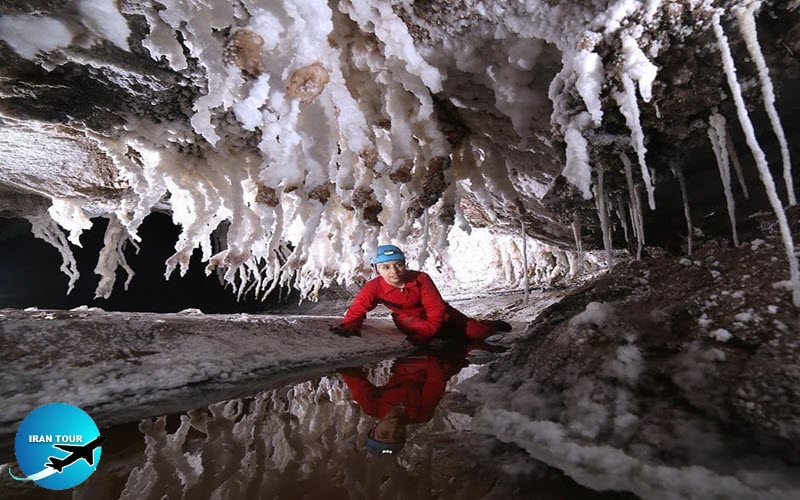 |
Even exploring the cave for three or four days would not suffice and bear results. They added that there is a large white mountain inside the cave made of crystal. Some others have said there are numerous large mountains in the middle of the cave. There is a small hole in the gorge of one of these mountains from which a big sea is visible. Despite its uniqueness, sufficient research has not been conducted on the Kotaleh Khour Cave due to the absence of linking roads and because the area is not within easy reach of big cities. During meetings of Iran's speleology committee, Koaleh Khour Cave has been declared as the only cave considered for research activities in the country and scientific circles have been informed of this issue officially. The first layer of the cave is 3250 meters long, which has a special glamour thanks to the diffusion of lights. There are other layers in the lower parts of the cave system, which have water in them and are decorated with columns and stalactites, and stalagmites.
- Details
- Category: What to see in IRAN